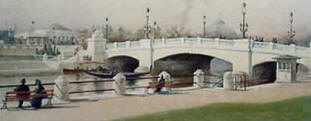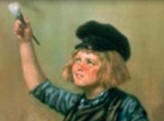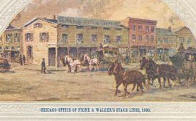Down in Kentucky where they make moonshine whiskey, breed feuds
and produce humans so poor that they are veritable children of the soil; down among the
Kentucky mountains there are people who, worthless and shiftless as they are, judged by
modern standards, furnish picturesque subjects for writers and artists. Every now
and then these people take to shooting one another, and then the world is reminded of the
existence of these peculiar mountain people. Then occasionally a writer such as John Fox
comes along with his "Trail of the Lonesome Pine," and other stories, and the
world again catches an intimate glimpse of these mountain people of the south.
Lawrence Earle, the artist who has been down in that country since last fall,
returned two weeks ago and brought a new collection of portrait sketches of the Kentucky
mountain people, also charming bits of Kentucky landscape, and this collection of his new
pictures was placed on view for the first time today at an exhibition of the Grand Rapids
Art association in its art gallery in the St. Cecilia building.
This is an exhibition which makes one gladly forget all about technique, methods
and the like, and just make the acquaintance of these quaint character types of
mountaineers.
Shiftless and Untrained
"This mountain country," said Mr. Earle, "was settled by the
Scotch-Irish combination which, under any circumstances, would result in more or less
temperament and stubbornness; but which left to run wild for generations has produced a
very unique people. Although shiftless and untrained, they have naturally good mentality,
and some of them are crude but sincere philosophers.
This quality shows in a portrait sketch the title of which is an interrogation
mark. The subject is an old man with white flowing beard, who holds in his hand a human
skull. The man is gaunt and emaciated. He is regarding the human relic with an intentness
of expression which suggests Hamlet's soliloquy, translated into the crude terms of his
own limited experience.
Viewed critically, the picture itself might create comment as varied as the
opinions of the persons viewing it. One person might find fault with the technique,
another might quibble over the brush strokes, while an extremist of the ultra modern
school would wave it aside at once because it shows at first glance exactly what it is and
precisely what the artist intended it to be, which futurists and other modern extremists
insist is very bad art.
"Had I tried to pose him," said Mr. Earle, "I probably should
have gotten an entirely different effect; but while I was arranging my materials he found
this skull, which had been unearthed recently and which was lying on the desk, and I
caught him in that position, apparently meditating after the manner of Hamlet's 'Alas,
Poor Yorrick.' He had forgotten all about me and as I worked he did not realize that I was
painting him."
Old Man King, Too
Then there is Burrel King, a fine old character with a face rugged and lined,
but with also a delicacy and refinement of features softened by his white hair and lighted
with a pair of deep blue eyes. "He is one of the best known characters in that
region," said Mr. Earle. The natives like to tell about old man King's wild ride. It
happened that his son had gotten into some trouble and had been arrested. The old man was
in possession of evidence of his innocence and in order to arrive in time rode many miles
at breakneck pace, killing two horses, literally riding them to death and he arrived in
time to save his son.
Squire Dave is another quaint character. He is drawn in profile, the long
patriarchal beard with eyes peering wisely from spectacles, giving him a solemn judicial
expression. "He is one of the few men who can read and write, he has picked up a
little law and some fragmentary information regarding legal forms and the drawing of legal
documents. They are crude and incorrect, but to the natives he is a great and learned man
and as a mark of respect they call him Squire."
Did Not Stay for Hands
The portrait sketch of "The First Settler" has unfinished hands.
"That old fellow posed under protest," said Mr. Earle. "He could not see
any sense in it at all. He seemed to grow more and more disgusted with the process and
after awhile when I paused to rearrange my materials, I looked up and he had gone. I had
finished everything but the hands and the cane upon which they rested. He was positively
the oldest inhabitant and a quaint old character."
"That fellow who is cataloged 'Chief of the Dirty Dozen,'" said Mr.
Earle, "is a type of the real hobo. I take him to be the original tramp, all the
others being mere imitators." He looks it in the portrait. There is also a bit of
humor expressed in the utter indifference to personal appearance and the care-free
confidence in all things.
"An Incorrigible" is a round-cheeked lad, whose claim to innocence
would be perfect except that he has a "bad squint in his eye."
"That boy is a perfect little terror," said Mr. Earle. "Young as
he is he chews tobacco, smokes, swears like a pirate and is an accomplished little thief.
How he can be all that and look so innocent is a puzzle to me."
"Owner of the Still" is a head and shoulders sketch of a woman. The
profile is strong, the long, pointed nose and sharp chin giving a beak-like appearance of
a bird of prey. The stoop of the shoulders suggests a life of toil.
"That woman runs a moonshine distillery," said Mr. Earle. "Her
husband is in jail for killing a man, so she runs the business. She has a keen mind and a
sharp keen business sense."
Mr. Earle is also exhibiting the figure of a boy from the coal mines which he
painted during a former trip to the Kentucky mountain
country.
Mr. Earle also has some interesting types of mountain girls, all of whom are
bright and attractive and each a distinct type. "The younger generation of
girls," said Mr. Earle, "are a decided improvement over their mothers. The
teachers who have come into the mountain country have done a great deal for them and
civilization is coming closer to them than to their mothers and the women of the past
generations."
Landscapes Are Interesting
Mr. Earle's landscapes and animals are very interesting. "The Mothers'
Meeting" is a bit of late autumn landscape with two sheep and their ewes in the
foreground.
An ox team, set in a well composed landscape, is called "A Mountain
Automobile." "A Darkey Outfit" is a ramshackle old lumber wagon to which
the bony horses are hitched with ropes and makeshift harness.
Among the smaller canvases, which are well painted bits of landscape, are
"The Road to Pine Knot," "A Mountain Road," "A Mountain
Cabin," "The Pool," "The Old Fireplace," "The Bank" and
"St. Stearns' Mill."
In strong contrast to the Kentucky sketches are a group of three beautiful
portraits by Mr. Earle, loaned by Philo C. Fuller, one being his mother, Mrs. E. P.
Fuller; his grand father, Judge Caroll, and Mrs. Fuller's mother. These portraits show Mr.
Earle's gift for portraying character. The portrait of Mrs. Fuller is a speaking likeness
and a very lovely portrait depicting the brightness and beauty of old age. The portrait of
Mrs. Fuller's mother is a strong character study, giving a sense of a well-rounded,
completed life, and over which broods the thought of futurity.
Mr. Earle also has three water colors, "The Belle of the Camp,"
"Little May" and "The Wandering Jew," which show a sure and facile
handling of the colors, the work being strong and fine.
GRAND RAPIDS PRESS. WEDNESDAY, MARCH 5, 1913 - Page 10



